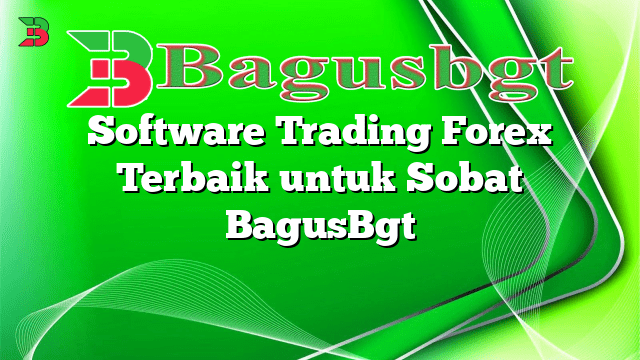Hello and welcome to our guide on forex trading strategy. In this article, we will discuss various strategies that can help you succeed in the dynamic world of forex trading. Whether you are a beginner or an experienced trader, having a solid strategy is crucial for making informed decisions and maximizing your profits in the forex market.
1. Understanding Forex Trading Strategy
Before diving into specific strategies, it is essential to understand the concept of forex trading strategy. A forex trading strategy refers to a set of rules and techniques adopted by traders to determine their entry and exit points in the market. It involves analyzing various factors, such as technical indicators, economic news, and market trends, to make informed trading decisions.
Advantages:
- Provides a structured approach to trading
- Helps in minimizing emotional decision-making
- Increases the probability of making profitable trades
Disadvantages:
- No strategy can guarantee 100% success
- Requires continuous monitoring and adjustments
- May not be suitable for all market conditions
2. Technical Analysis Strategy
One popular forex trading strategy is technical analysis. It involves analyzing historical price data, charts, and indicators to identify patterns and predict future price movements. Traders using this strategy rely on indicators like moving averages, RSI, MACD, and Fibonacci retracements to make trading decisions.
Advantages:
- Uses objective data for analysis
- Helps in identifying trends and reversals
- Provides clear entry and exit signals
Disadvantages:
- May generate false signals during choppy markets
- Requires a good understanding of technical indicators
- Can be time-consuming to analyze charts
3. Fundamental Analysis Strategy
Another approach to forex trading strategy is fundamental analysis. This strategy involves analyzing economic indicators, news events, and geopolitical factors that impact currency values. Traders using fundamental analysis assess factors such as interest rates, GDP growth, inflation, and central bank policies to make trading decisions.
Advantages:
- Provides a long-term perspective on currency movements
- Helps in understanding the underlying market conditions
- Can identify trading opportunities based on news events
Disadvantages:
- Requires in-depth knowledge of economic indicators
- Market reactions to news events can be unpredictable
- Not suitable for short-term traders
4. Breakout Strategy
The breakout strategy is based on the concept that significant price movements often occur after a period of consolidation. Traders using this strategy identify key support and resistance levels and enter trades when the price breaks out of these levels, expecting a strong price movement in the breakout direction.
Advantages:
- Can generate high-profit potential during strong trends
- Provides clear entry and exit levels
- Can be applied to various timeframes
Disadvantages:
- False breakouts can lead to losses
- Requires patience to wait for valid breakout signals
- Not suitable for range-bound markets
5. Carry Trade Strategy
The carry trade strategy takes advantage of interest rate differentials between currencies. Traders using this strategy borrow funds in a low-interest-rate currency and invest in a higher-interest-rate currency. The goal is to earn the interest rate differential while profiting from currency appreciation.
Advantages:
- Can generate consistent returns from interest differentials
- Does not rely on price movements for profitability
- Can be used in both bullish and bearish markets
Disadvantages:
- Exchange rate fluctuations can erode profits
- Requires careful selection of currency pairs
- Market conditions and central bank policies can impact returns
6. Momentum Strategy
The momentum strategy is based on the principle that strong price movements tend to continue in the same direction. Traders using this strategy identify assets that are experiencing significant price momentum and enter trades in the direction of the prevailing trend.
Advantages:
- Can generate high-profit potential during strong trends
- Allows traders to ride the momentum wave
- Provides clear entry and exit signals
Disadvantages:
- Can result in losses during trend reversals
- Requires timely entry and exit to maximize profits
- Not suitable for range-bound or choppy markets
7. Range Trading Strategy
The range trading strategy is suitable for markets that lack a clear trend and are trading within a defined range. Traders using this strategy identify support and resistance levels and enter trades when the price reaches these levels, expecting a reversal in the opposite direction.
Advantages:
- Can generate profits in range-bound markets
- Provides clear entry and exit levels
- Allows for quick trades with limited risk
Disadvantages:
- False breakouts can lead to losses
- Requires patience to wait for valid entry signals
- Not suitable for trending markets
8. Scalping Strategy
The scalping strategy aims to make small profits from multiple trades throughout the day. Traders using this strategy enter and exit trades quickly, taking advantage of short-term price fluctuations. Scalpers rely on technical indicators, such as moving averages and oscillators, to identify short-term trading opportunities.
Advantages:
- Can generate quick profits with multiple trades
- Allows traders to capitalize on short-term price movements
- Provides frequent trading opportunities
Disadvantages:
- Requires a high level of focus and concentration
- Transaction costs can significantly impact profitability
- Not suitable for traders with limited time availability
9. Hedging Strategy
The hedging strategy is used to minimize the risk associated with adverse price movements. Traders using this strategy open positions in opposite directions to offset potential losses. Hedging can be done by trading correlated currency pairs or by using derivative products, such as options or futures.
Advantages:
- Reduces the risk of significant losses
- Provides a level of protection during volatile market conditions
- Allows traders to maintain open positions without excessive exposure
Disadvantages:
- Can limit profit potential if the market moves favorably
- Requires careful position sizing and risk management
- Additional costs may be involved in hedging positions
10. Alternative Forex Trading Strategies
While the strategies mentioned above are widely used, there are also alternative approaches to forex trading strategy. Some traders focus on price action trading, which involves analyzing raw price data without the use of indicators. Others prefer algorithmic trading, where computer programs execute trades based on predefined rules.
Conclusion:
Choosing the Right Forex Trading Strategy
Each forex trading strategy has its own strengths and weaknesses. The key to successful trading is to choose a strategy that aligns with your trading style, risk tolerance, and market conditions. It is also important to continuously educate yourself, test different strategies, and adapt to changing market dynamics. Remember, there is no one-size-fits-all strategy in forex trading. What works for one trader may not work for another. By developing a well-defined strategy and sticking to it, you can increase your chances of success in the forex market.
Forex Trading Strategy |
Advantages |
Disadvantages |
|---|---|---|
Technical Analysis |
Uses objective data for analysis |
May generate false signals during choppy markets > Requires a good understanding of technical indicators > Can be time-consuming to analyze charts |
Fundamental Analysis |
Provides a long-term perspective on currency movements |
Requires in-depth knowledge of economic indicators |
Breakout Strategy |
Can generate high-profit potential during strong trends |
False breakouts can lead to losses |
Carry Trade Strategy |
Can generate consistent returns from interest differentials |
Exchange rate fluctuations can erode profits |
Momentum Strategy |
Can generate high-profit potential during strong trends |
Can result in losses during trend reversals |
Range Trading Strategy |
Can generate profits in range-bound markets |
False breakouts can lead to losses |
Scalping Strategy |
Can generate quick profits with multiple trades |
Requires a high level of focus and concentration |
Hedging Strategy |
Reduces the risk of significant losses |
Can limit profit potential if the market moves favorably |
Frequently Asked Questions (FAQs)
Q: Is there a best forex trading strategy?
A: There is no one-size-fits-all approach to forex trading strategy. The best strategy for you will depend on your trading style, risk tolerance, and market conditions.
Q: How do I choose the right strategy?
A: To choose the right strategy, consider your goals, trading experience, and available time. It is also important to backtest and demo trade different strategies to see which one suits you best.
Q: Can I combine multiple strategies?
A: Yes, it is possible to combine different strategies to create a customized approach. However, it is essential to ensure that the strategies are compatible and complement each other.
Q: How often should I review and adjust my strategy?
A: It is recommended to review and adjust your strategy regularly, especially when market conditions change. However, avoid making frequent changes based on short-term results.
Q: Is forex trading strategy suitable for beginners?
A: Yes, having a well-defined strategy is crucial for beginners and experienced traders alike. It provides a structured approach and helps in minimizing emotional decision-making.
Closing Thoughts
In conclusion, a solid forex trading strategy is essential for success in the forex market. Whether you choose technical analysis, fundamental analysis, or any other approach, it is crucial to understand the advantages, disadvantages, and suitability of each strategy. Remember to align your strategy with your trading style and risk tolerance, continuously educate yourself, and adapt to changing market conditions. With proper planning and discipline, you can increase your chances of achieving consistent profitability in forex trading.
 Bagus Banget Kumpulan Informasi terbaru dari berbagai sumber yang terpercaya
Bagus Banget Kumpulan Informasi terbaru dari berbagai sumber yang terpercaya


